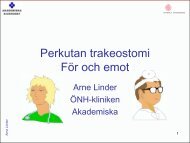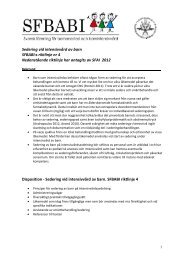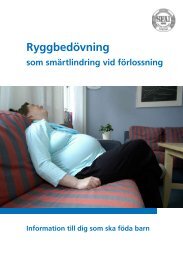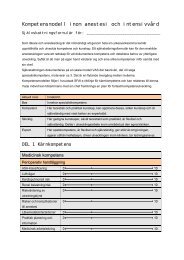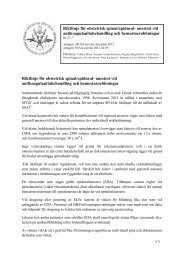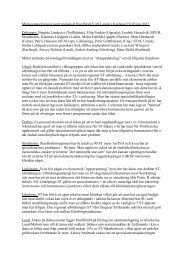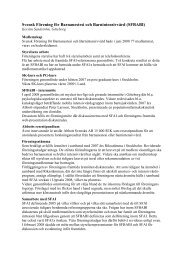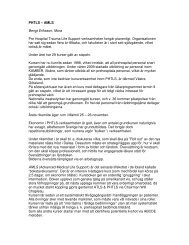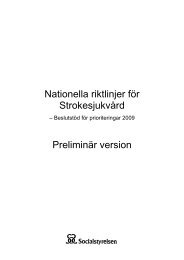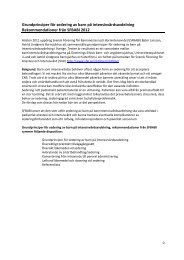2010 Vol. 16 Nr 3 - SFAI
2010 Vol. 16 Nr 3 - SFAI
2010 Vol. 16 Nr 3 - SFAI
- No tags were found...
Create successful ePaper yourself
Turn your PDF publications into a flip-book with our unique Google optimized e-Paper software.
1946SPIKBLAD SPIKBLAD SPIKBLAD SPIKBLAD SPIKBLAD SPIKBLAD SPIKBLAD SPIKBLAD SPIKBLADLinköping University Medical DissertationsNo. 1195Effects of burns and vasoactive drugs on human skin,-Clinical and Experimental studies using microdialysisAnders SamuelssonAkademisk avhandlingsom för avläggande av medicine doktorsexamen vid Linköpings universitet offentligt försvarades i Berzeliussalen,Hälsouniversitetet, fredagen den 8 oktober <strong>2010</strong>, kl.13,00Fakultetsopponent var professor Ola Winsö, Institutionen för Kirurgisk och Perioperativ Vetenskap, Avdelningen förAnestesiologi och Intensivvård, Umeå Universitet.AbstractPatients who require critical care, including those with burns,are affected by a systemic inflammatory reaction, which attimes has consequences such as multiple organ dysfunctionand failure. It has become increasingly evident that otherfactors important in the development of organ dysfunctionare disturbances at the tissue level, in the microcirculation.Such disturbances activate cascade systems including stresshormones, all of which have local effects on organ function.Despite this knowledge, monitoring and treatment in criticalillness today relies mainly on central haemodynamics andblood sampling.Microdialysis is a minimally invasive technique thatenables us to study the chemical composition and changesin biochemistry in the extracellular, extravascular space inliving tissues. Most of our current experience is from animalmodels, but the technique has also been used in humans andhas become routine in many neurosurgical intensive careunits to monitor brain biochemistry after severe injury. Inskin, this experience is limited.During the first half of this thesis we studied the injured anduninjured skin of severely burned patients. The results showthat there are severe local metabolic disturbances in bothinjured and uninjured skin. Most interesting is a sustainedtissue acidosis, which is not detectable in systemic (blood)sampling. We also recorded considerable alterations in theglucose homeostasis locally in the skin, suggesting a cellularor mitochondrial dysfunction. In parallel, we noted increasedtissue glycerol concentrations, which indicated appreciabletrauma-induced lipolysis.We also examined serotonin kinetics in the same group ofpatients, as serotonin has been claimed to be a key mediatorof the vasoplegia and permeability disturbances found inpatients with burns. We have shown, for the first time inhumans to our knowledge, that concentrations of serotoninin skin are increased tenfold, whereas blood and urineconcentrations are just above normal. The findings supportthe need for local monitoring of substances with rapid localreabsorption, or degradation, or both. The results also indicatethat serotonin may be important for the systemic responsethat characterises burn injuries.In the second half of the thesis we evaluated the effectsof microdosing in skin on metabolism and blood flow ofvasoactive, mainly stress-response-related, drugs by themicrodialysis system. The objectives were to isolate thelocal effects of the drugs to enable a better understanding ofthe complex relation between metabolic effects and effectsinduced by changes in local blood flow. In the first of thesetwo studies we showed that by giving noradrenaline andnitroglycerine into the skin of healthy subjects we inducedanticipated changes in skin metabolism and blood flow.The results suggest that the model may be used to examinevascular and metabolic effects induced locally by vasoactivecompounds. Data from the last study indicate that conventionalpharmacodynamic models (E max) for time and dose responsemodelling may be successfully used to measure the vascularand metabolic response in this microdosing model.We conclude that the microdialysis technique can besuccessfully used to monitor skin metabolism and isolatea mediator (serotonin) of the local skin response in burnedpatients. It was also feasible to develop a vascular model inskin based on microdialysis to deliver vasoactive substanceslocally to the skin of healthy volunteers. This model provideda framework in which the metabolic effects of hypoperfusionand reperfusion in skin tissues could be examined further.Departments of Medicine and Health Sciences, Division of Drug Research/Anaesthesiology and Clinicaland Experimental Medicine, Faculty of Health Sciences Linköpings Univerity, S-581 85 Linköping. SwedenLinköping <strong>2010</strong>ISBN 978-91-7393-342-1 ISSN 0345-0082186 <strong>SFAI</strong>-Tidningen <strong>Nr</strong> 3 <strong>2010</strong>SOCIETAS SVECICAANAESTHESIOLOGIAE CVRAEQVE INTENSIVAE



